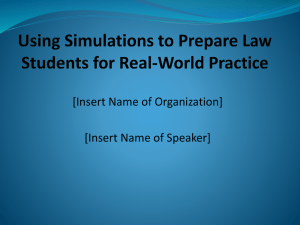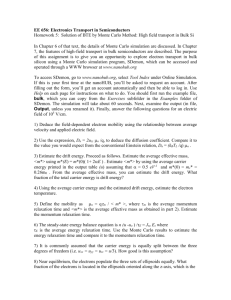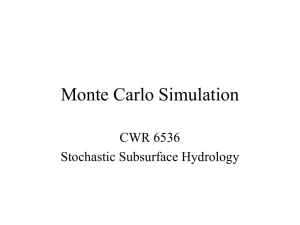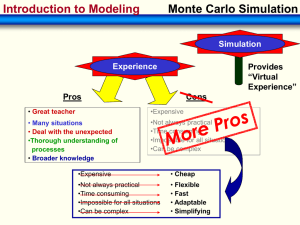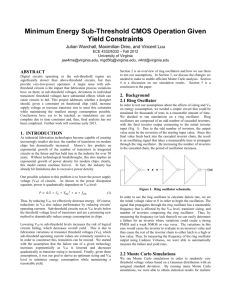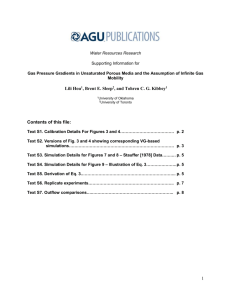SupplementaryTables
advertisement
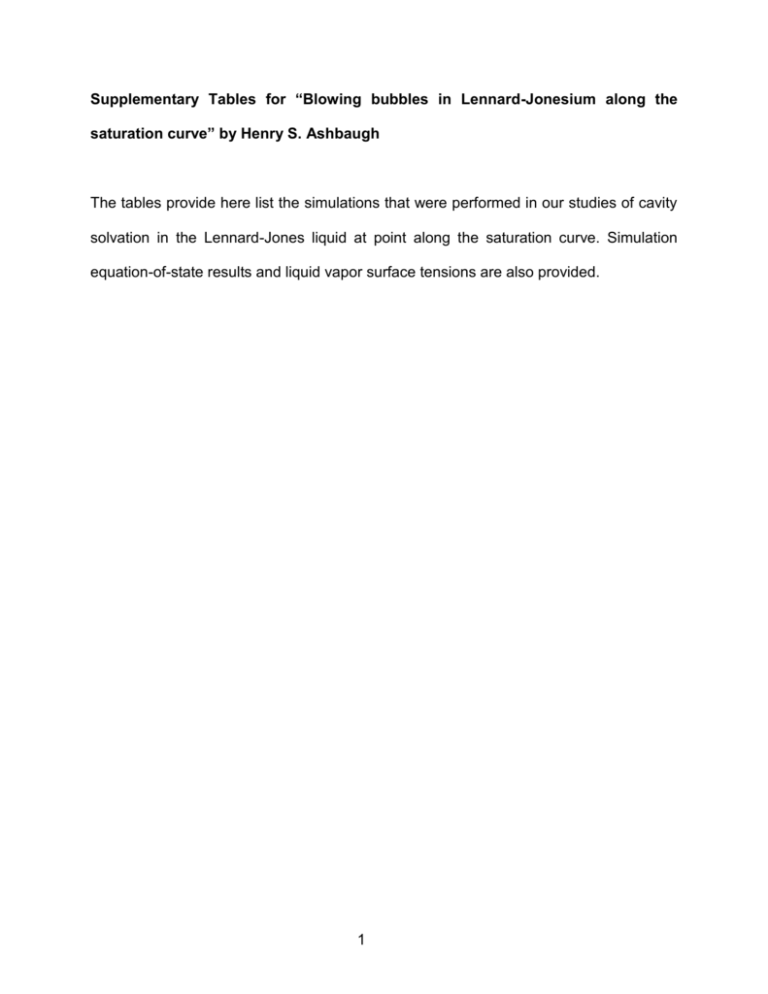
Supplementary Tables for “Blowing bubbles in Lennard-Jonesium along the saturation curve” by Henry S. Ashbaugh The tables provide here list the simulations that were performed in our studies of cavity solvation in the Lennard-Jones liquid at point along the saturation curve. Simulation equation-of-state results and liquid vapor surface tensions are also provided. 1 Table S1. Listing of grand canonical transition matrix Monte Carlo simulations of the cut-shifted (rc = 2.5) LJ fluid following the algorithm described by Errington1. The range of temperatures extends from kT/ = 0.65 to close to the critical point. The length of the cubic simulation box is designated by L = 8. Averages were collected over Nsweeps = 2x109 (one sweep corresponds to either an attempted particle move, particle insertion, or particle deletion, with each possible move chosen with equal probability) after equilibration for at least 107 sweeps. The average vapor density, liquid density, and saturation pressure are listed with the error in the final digit reported in parentheses as one standard deviation. The critical temperature, pressure, and density determined by critical scaling are kTc/ = 1.079(1), Pc3/= 0.0959(1), and c3 = 0.321(1)2. kT/ <vap3> <liq3> <P3/> 0.650 0.0044(3) 0.813(2) 0.0034(3) 0.675 0.0058(4) 0.8008(3) 0.0045(4) 0.700 0.0076(4) 0.7877(4) 0.0068(3) 0.725 0.0098(3) 0.7740(6) 0.0075(5) 0.750 0.0126(3) 0.7603(3) 0.0096(6) 0.775 0.0159(2) 0.7459(7) 0.0121(7) 0.800 0.0200(1) 0.7311(6) 0.0150(7) 0.825 0.0247(6) 0.7157(7) 0.0185(8) 0.850 0.03045(1) 0.6995(1) 0.0226(8) 0.875 0.03719(4) 0.6825(1) 0.0273(8) 0.900 0.04520(2) 0.6641(5) 0.0327(8) 0.925 0.05476(4) 0.6444(6) 0.0388(9) 2 0.950 0.0663(2) 0.6232(6) 0.0458(9) 0.975 0.0805(5) 0.5994(3) 0.0537(9) 1.000 0.098(1) 0.572(1) 0.062(1) 1.025 0.124(1) 0.539(2) 0.073(1) 1.050 0.160(2) 0.494(2) 0.084(1) 1.060 0.177(6) 0.472(4) 0.088(1) 3 Table S2. Listing of canonical ensemble Monte Carlo simulations of a slab of liquid in equilibrium with its vapor at temperatures of kT/ = 0.65 to 1.00 in increments of 0.05. The initial densities of the vapor and liquid slabs was set to the binodal values determined from the transition matrix Monte Carlo simulations (Table 1). The bulk densities were retained during the coarse of the simulations. The x, y, and z box lengths are Lx, Ly, and Lz, respectively. The liquid-vapor surface tension was averaged over Ncycles = 107 (one cycle corresponds to one attempted to move for each solvent molecule), after equilibration for at least 100,000 cycles. The surface tension was evaluated via the virial formula3. The average surface tension is listed with the error in the final digit reported in parentheses as one standard deviation. kT/ N vap3 liq3 Lx,y/ Lz/ <lv2/> 0.65 1200 0.0044 0.813 10 50 0.690(4) 0.70 1200 0.0076 0.7877 10 50 0.590(4) 0.75 1200 0.0126 0.7603 10 50 0.496(4) 0.80 1200 0.0200 0.7311 10 50 0.406(4) 0.85 1200 0.0305 0.6995 10 50 0.315(2) 0.90 1200 0.0452 0.6641 10 50 0.2361(6) 0.95 1200 0.0663 0.6232 10 50 0.159(1) 1.00 1400 0.0980 0.5718 9 70 0.093(1) 4 Table S3. Listing of isothermal-isobaric ensemble Monte Carlo simulations of N = 1000 LJ particles. Simulations were carried out at kT/ = 0.65 to 1.00 in increments of 0.05 along the saturation curve. Both the equilibrium liquid and gas phase densities were simulated at each temperature. Cavity insertion probabilities were averaged over Ncycles = 107 (one cycle corresponds to one attempted to move for each solvent molecule), after equilibration for at least 100,000 cycles. kT/ P3/ 0.65 0.0034 0.70 0.0068 0.75 0.0096 0.80 0.015 0.85 0.023 0.90 0.033 0.95 0.046 1.00 0.062 5 Table S4. Listing of isothermal-isobaric ensemble Monte Carlo simulations of N LJ particles and a single hard-sphere of radius R. Simulations were performed at temperatures from kT/ = 0.65 to 1.00 in increments of 0.05 at the saturation pressure (Table 3). Averages for the density of the solvent in contact with the cavity were carried out over Ncycles (One cycle corresponds to one attempted to move for the cavity and each solvent molecule. Volume moves were attempted every fifth cycle), after equilibration for at least 100,000 cycles. For some of the larger cavities at temperatures approaching the critical point additional larger simulations with more solvent particles were performed to ensure the contact density corresponds to that of a cavity at infinite dilution. No statistically significant changes were observed. R/ kT/ N Ncycles 0.25 0.65 – 1.00 750 106 0.50 0.65 – 1.00 750 106 0.75 0.65 – 1.00 750 106 1.00 0.65 – 1.00 1000 106 1.50 0.65 – 1.00 1000 106 2.00 0.65 – 1.00 1500 106 2.50 0.65 – 1.00 2000 106 3.00 0.65 – 1.00 2000a 106 3.50 0.65 – 1.00 2500b 7.5x105 4.00 0.65 – 1.00 2500c 7.5x105 4.50 0.65 – 1.00 3000d 5x105 5.00 0.65 – 1.00 3500e 5x105 6 kT/ = 0.95 and 1.00 an additional simulation with N = 2500 was performed. kT/ = 0.95 and 1.00 an additional simulation with N = 3000 was performed. cFor kT/ = 0.95 and 1.00 an additional simulation with N = 3500 was performed. dFor kT/ = 0.95 and 1.00 an additional simulation with N = 4000 was performed. eFor kT/ = 0.95 and 1.00 an additional simulation with N = 4500 was performed. aFor bFor 7 References 1 2 3 J. R. Errington, J. Chem. Phys. 118, 9915 (2003). J. S. Rowlinson and F. L. Swinton, Liquids and Liquid Mixtures, third ed. (Butterworth Scientific, London, 1982). J. S. Rowlinson and B. Widom, Molecular theory of capilarity. (Dover Publications, Mineola, New York, 2002). 8



